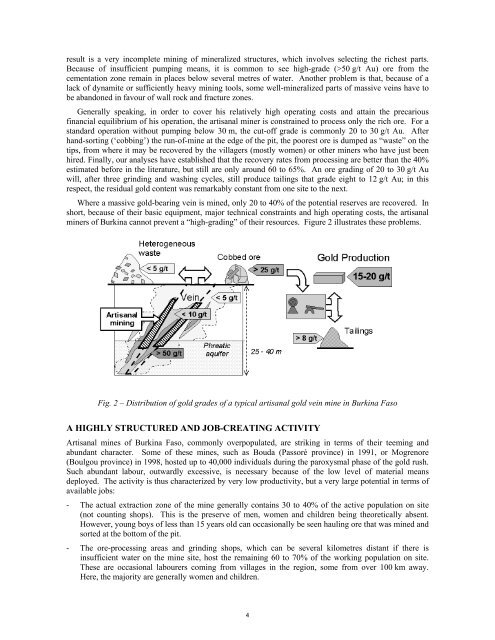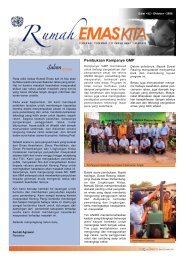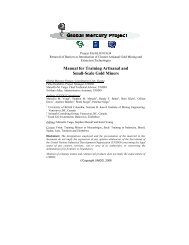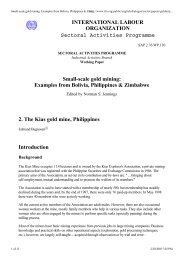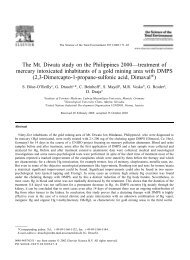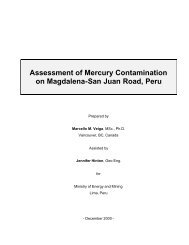ARTISANAL AND SMALL-SCALE GOLD MINES IN BURKINA FASO ...
ARTISANAL AND SMALL-SCALE GOLD MINES IN BURKINA FASO ...
ARTISANAL AND SMALL-SCALE GOLD MINES IN BURKINA FASO ...
Create successful ePaper yourself
Turn your PDF publications into a flip-book with our unique Google optimized e-Paper software.
esult is a very incomplete mining of mineralized structures, which involves selecting the richest parts.<br />
Because of insufficient pumping means, it is common to see high-grade (>50 g/t Au) ore from the<br />
cementation zone remain in places below several metres of water. Another problem is that, because of a<br />
lack of dynamite or sufficiently heavy mining tools, some well-mineralized parts of massive veins have to<br />
be abandoned in favour of wall rock and fracture zones.<br />
Generally speaking, in order to cover his relatively high operating costs and attain the precarious<br />
financial equilibrium of his operation, the artisanal miner is constrained to process only the rich ore. For a<br />
standard operation without pumping below 30 m, the cut-off grade is commonly 20 to 30 g/t Au. After<br />
hand-sorting (‘cobbing’) the run-of-mine at the edge of the pit, the poorest ore is dumped as “waste” on the<br />
tips, from where it may be recovered by the villagers (mostly women) or other miners who have just been<br />
hired. Finally, our analyses have established that the recovery rates from processing are better than the 40%<br />
estimated before in the literature, but still are only around 60 to 65%. An ore grading of 20 to 30 g/t Au<br />
will, after three grinding and washing cycles, still produce tailings that grade eight to 12 g/t Au; in this<br />
respect, the residual gold content was remarkably constant from one site to the next.<br />
Where a massive gold-bearing vein is mined, only 20 to 40% of the potential reserves are recovered. In<br />
short, because of their basic equipment, major technical constraints and high operating costs, the artisanal<br />
miners of Burkina cannot prevent a “high-grading” of their resources. Figure 2 illustrates these problems.<br />
Fig. 2 – Distribution of gold grades of a typical artisanal gold vein mine in Burkina Faso<br />
A HIGHLY STRUCTURED <strong>AND</strong> JOB-CREAT<strong>IN</strong>G ACTIVITY<br />
Artisanal mines of Burkina Faso, commonly overpopulated, are striking in terms of their teeming and<br />
abundant character. Some of these mines, such as Bouda (Passoré province) in 1991, or Mogrenore<br />
(Boulgou province) in 1998, hosted up to 40,000 individuals during the paroxysmal phase of the gold rush.<br />
Such abundant labour, outwardly excessive, is necessary because of the low level of material means<br />
deployed. The activity is thus characterized by very low productivity, but a very large potential in terms of<br />
available jobs:<br />
- The actual extraction zone of the mine generally contains 30 to 40% of the active population on site<br />
(not counting shops). This is the preserve of men, women and children being theoretically absent.<br />
However, young boys of less than 15 years old can occasionally be seen hauling ore that was mined and<br />
sorted at the bottom of the pit.<br />
- The ore-processing areas and grinding shops, which can be several kilometres distant if there is<br />
insufficient water on the mine site, host the remaining 60 to 70% of the working population on site.<br />
These are occasional labourers coming from villages in the region, some from over 100 km away.<br />
Here, the majority are generally women and children.<br />
4


